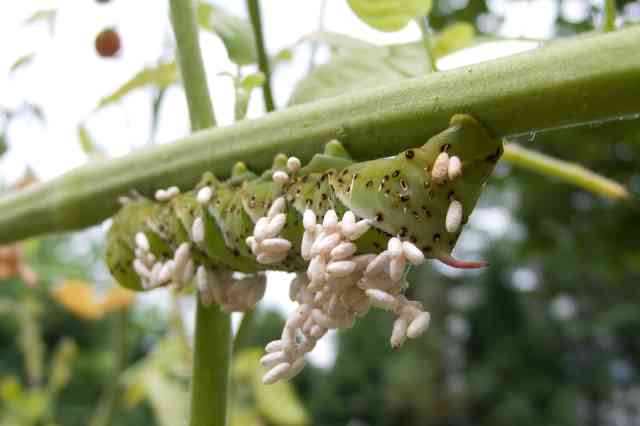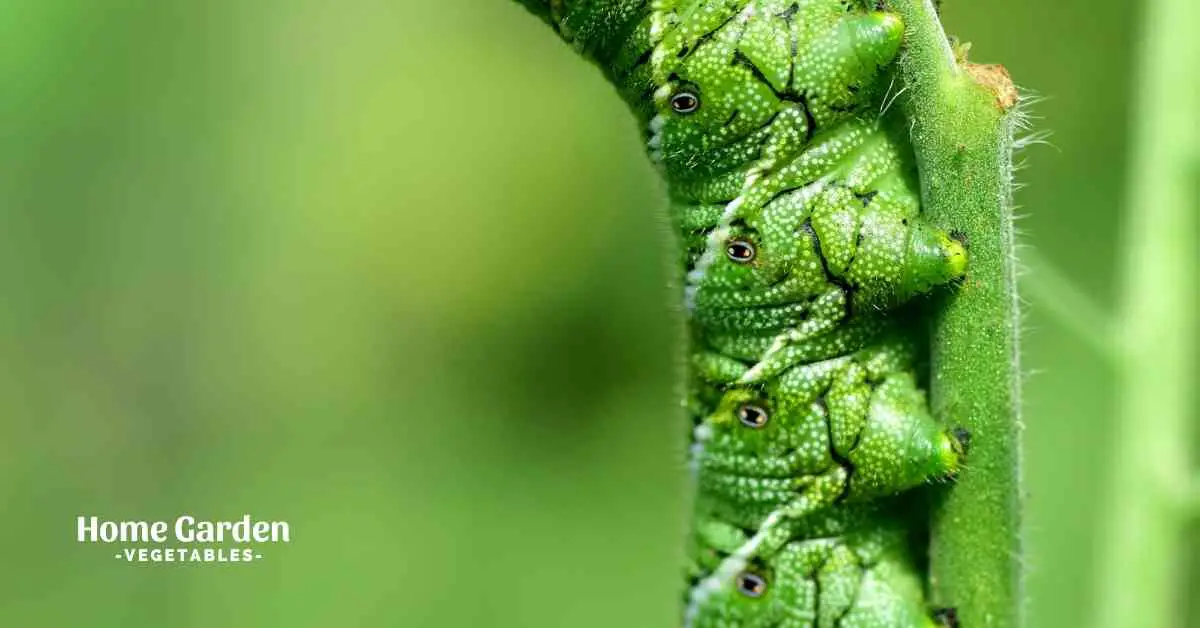If you’ve been growing tomatoes, there are high chances that you’ve encountered tomato hornworms. Tomato hornworms, often confused with tobacco hornworms, are green caterpillars that can devastate your tomato crop. Other than tomatoes, they also feed on other plants from the nightshade family, including eggplant, pepper, potatoes and tobacco.
Amidst the frustration and schemes to get rid of them, did you ever stop to think where do tomato hornworms come from? In fact, learning about their life cycle can give you some useful insight on how to overpower them. Continue reading and you’ll learn all about their development, how they emerge in your garden and some useful tips on how to get rid of them.
Reader Poll: What online courses would interest you?

How To Identify Tomato Hornworms
Tomato hornworms exist in two major forms during different stages of their lifecycle which you’ll learn later in the same post. Here’s how the pest is identified in these stages of its life.
- Caterpillar
Tomato hornworms are large caterpillars that can measure up to 5 inches long. Younger caterpillars are yellowish white in color and have no markings on them. As they grow bigger, they develop a green color with 8 V-shaped white marks on each side. They have a black horn-like structure protruding out the rear part of their body. With their pale green bodies, they blend well with the plant foliage, making it difficult to spot unless you observe closely.
The tomato hornworm caterpillars are distinguished from tobacco hornworms in that tobacco hornworms have parallel white stripes on their bodies and a red horn sticking out their tail end as opposed to the white ‘V’ shaped markings and black horn of the tomato hornworms. Both varieties attack nightshade crops and damage them severely.
Subscribe to our newsletter!
- Adult Moths
The caterpillars come from a large mottled brown-grey moth. They have narrow front wings and yellow spots on the sides of the abdomen. The rear wings have alternating bands of light and dark shades. The moth is heavy-bodied and has a wingspread of about 4 to 5 inches.
Life Cycle Of Tomato Hornworms – Where Do They Come From

Tomato hornworms overwinter in your garden soil as pupae and surface in spring in the form of adult moths. So where do these pupae come from?
The female tomato hornworm moths deposit small light green eggs on the leaves. You’ll typically find these eggs on the underside of the leaves of host plants in summers since that’s when they lay eggs.
The eggs hatch into caterpillars which begin feeding on the host plant and grow to their full size in just about three to four weeks. Once fully mature, the caterpillars drop off the foliage to the soil, transforming into pupae.
From the pupae, second generation moths appear in about 2 weeks during the same season. This happens around mid-summer while the weather is still ideal for laying eggs. The second generation moths lay eggs on the host plants, from which caterpillars emerge and feed until early fall.
When the warm weather subsides, they’ll drop to the ground, transforming into pupae that will overwinter and appear in your garden as brown moths as soon as the weather warms up in spring.
Damage Caused By Tomato Hornworms
Since the caterpillars blend well with the color of the leaves, it’s hard to notice their existence until plenty of damage is done. They start by feeding on the leaves on the upper part of the plants. If the stems on the upper part of the plants are leafless, it’s likely that tomato hornworms have been feeding on them. If a large number of caterpillars are present in the garden, they can quickly defoliate the plants.
Another indication of tomato hornworms is the black or dark green droppings they leave behind as they feed. Older tomato hornworms will also feed on the flowers and the fruit. The fruit may also suffer damage from sunscald as a result of defoliation.
How To Protect Your Garden Against Tomato Hornworms
The best way to protect your garden is using a combination of control and prevention techniques.
Control
If you find tomato hornworms in the garden, there are a few things you can do to get rid of them. Here are a few tips that will work:
- Handpicking is one of the simplest and most effective techniques against the caterpillars. They won’t bite or sting so you can go ahead and pick them off the plant and destroy them. If you’re squeamish about crushing them, you can drop them in a bucket of soapy water to kill them. They’ll also make a good treat for chickens.
- Insecticidal soaps also work against tomato hornworms but the insect will need to contact it directly for it to be effective. You’ll need to spray the soap directly onto the pest and repeat applications as needed since there’s no residual activity.
- Bacillus thuringiensis is a good organic pesticide that works as a stomach poison on certain larvae insects, including tomato hornworms. The good news is that it won’t kill beneficial insects, including bees. It works best on younger caterpillars and the caterpillar will need to ingest the pesticide for it to work. You’ll have to reapply the product after a rain.
Prevention

Prevention is typically easier than controlling the problem once it occurs. Good gardening practices can keep your garden free of pests, including tomato hornworms. Here are some prevention techniques that will keep tomato hornworms out:
- Remove weeds to reduce favorable sites for laying eggs.
- Introduce dill, marigold and basil as companion plants in your garden.
- Till the soil after harvest to kill the overwintering pupae.
- Introduce and encourage beneficial insects, including wasps, green lacewings and ladybugs.
Conclusion
Where do tomato hornworms come from? Seems like it’s an endless cycle in which they overwinter as pupae, resurface as moths, lay eggs, feed, pupate and repeat. Unless you break this cycle with some strong control and prevention techniques, tomato hornworms will continue damaging the crops season after season. Protect your beautiful crops against tomato hornworms while there’s still time.

